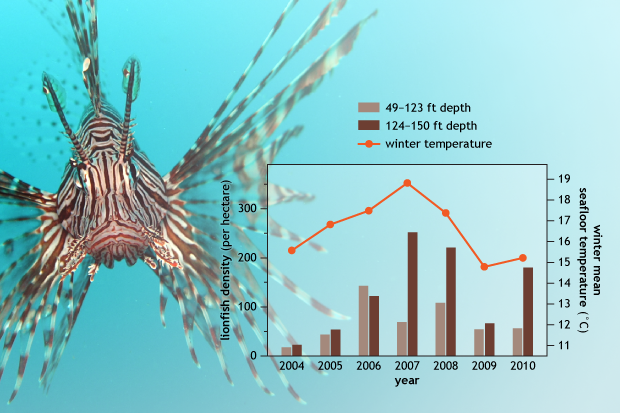Warming Atlantic may invite greedy lionfish to North Carolina coast
Details
Zebra mussels, lionfish, and jellies, oh my! Warming ocean temperatures in the Atlantic may allow for the expansion of tropical fish species into areas formerly too cold for them to thrive. Few are as worrisome to people who manage and depend on healthy coastal and reef ecosystems as the spectacular-looking and voracious lionfish—a fish with few if any predators outside the tropics.
A recent study of 40 species of marine creatures that live near the North Carolina coast found a definite connection between warm winters and the density of lionfish (Pterois volitans)—a sign that the damaging fish may expand into the region as climate warms.
The graph on the right shows lionfish densities in North Carolina’s Onslow Bay by year and depth zone. The light brown bar represents the density of lionfish at depths of 15-37 meters (49-123 feet), and the dark brown bar represents the species’ density at the deeper depths of 38-46 meters (124-150 feet). Overall, the researchers found that lionfish densities increased from 2004-2007, but decreased back to pre-2006 levels in 2009 with the onset of particularly cold winter bottom temperatures. The line at the top of the graph shows the mean winter seafloor temperature in degrees Celsius. The lionfish were only observed in locations with a winter mean temperature of 15.3°C (roughly 59.5°F) and higher.
Lionfish, which only arrived in North Carolina’s waters around the year 2000, are considered a major threat to Atlantic reefs. Since their first sighting off of Florida’s East Coast in the late 1980s, lionfish populations have swelled throughout the western North Atlantic, the Gulf of Mexico, and the Caribbean. The fish has a huge appetite and few to no natural predators (its spines contain neurotoxins), which means it can reduce the populations of native reef fish, leading to decreased reef health.
Scientists believe that colder water temperatures are one of the few environmental factors that control the species’ distribution on a large scale. As more shallow waters warm as a result of climate change, lionfish and other invasive species may expand their range and begin affecting presently untouched ecosystems.
Image by Fiona Martin, based on photo by Jens Peter, available via Creative Commons License through WIkimedia. Graph adapted Whitfiled et al. (used with permission.)
Reference
Whitfield, P. E., Muñoz, R. C., Buckel, C. A., Degan, B. P., Freshwater, D. W., & Hare, J. A. (2014). Native fish community structure and Indo-Pacific lionfish Pterois volitans densities along a depth-temperature gradient in Onslow Bay, North Carolina, USA. Marine Ecology Progress Series, 509, 241–254. doi:10.3354/meps10882
